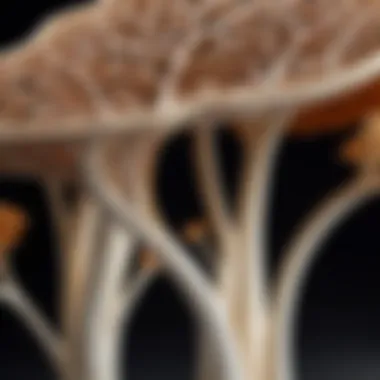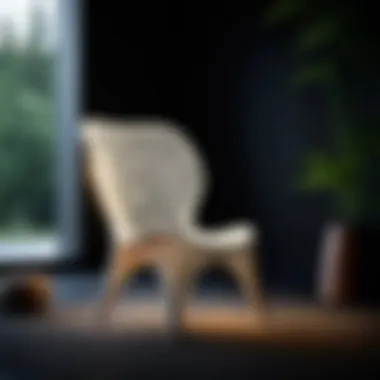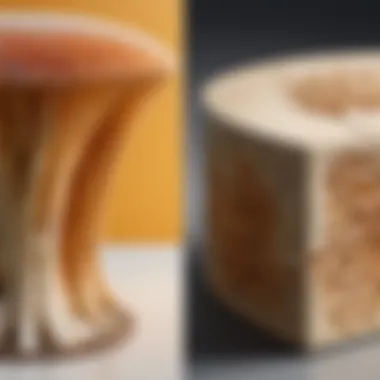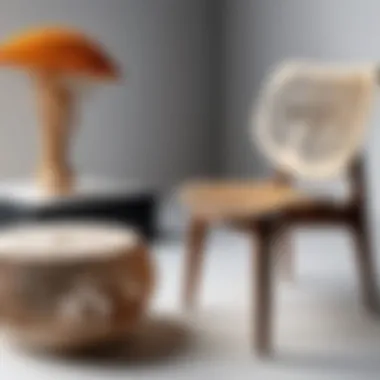Exploring Mycelium Furniture: A Sustainable Design Revolution


Intro
Mycelium furniture represents an exciting intersection between innovation and sustainability. Mycelium, the root system of fungi, has gained attention in recent years as a versatile material for creating furniture. The biological properties of mycelium allow for unique designs while offering an ecological alternative to conventional materials, which often rely on unsustainable practices.
As the design industry grapples with the necessity for sustainability, mycelium furniture emerges as a revolutionary option that challenges traditional methodologies. This article will explore various facets of mycelium furniture, including production processes that harness this organism's natural growth, its sustainability credentials, and potential implications for the future of design.
Technology Insights
In the realm of mycelium furniture, several technological advancements are pivotal. Understanding these technologies allows designers to harness the full potential of this innovative material.
Latest Tech Trends
The integration of mycelium in furniture design is not just about aesthetics; it also aligns with emergent tech trends that emphasize biomimicry and eco-consciousness. Companies like Ecovative Design have pioneered methods of growing mycelium into specific shapes and structures, demonstrating that technology can be a partner in sustainability.
Innovation in Tech
The process of cultivating mycelium includes utilizing agricultural waste, making it a low-carbon alternative. This innovative manufacturing process drastically reduces the environmental footprint associated with conventional furniture production. The continuous exploration of different fungal species also contributes to diverse textures and strengths in the final products.
"The future of design is not only about what we create but how responsibly we do it, and mycelium stands at the forefront of this movement."
Product Reviews
Several brands have started to experiment with mycelium for furniture production. One notable example is the chair created by the design studio MUSH, which showcases the soft yet sturdy qualities of mycelium. This chair is not only visually appealing, but it is also compostable at the end of its life cycle, aligning perfectly with sustainable practices.
Industry Spotlights
The influence of mycelium furniture extends beyond individual products to impact the broader design industry. Insights from design experts and innovative studios reveal a growing interest in this sustainable material.
Designers to Watch
Designers like Studio AYASKANTHA are leading the charge in developing mycelium-based furniture. Their methodologies blend art and practicality, providing a compelling case for the use of biological materials in design.
The End
Exploring mycelium furniture raises questions and possibilities about the future of sustainable design. Understanding its production processes, innovations, and market trends provides a fuller picture of the potential impact this material can have on the design industry. Ultimately, mycelium furniture serves as a testament to what can be achieved when creativity meets ecological responsibility.
The journey of mycelium in furniture design is just beginning, and its ultimate success may depend on the collective commitment of designers, consumers, and industries alike.
Prologue to Mycelium Furniture
The introduction of mycelium furniture marks a significant shift in the world of sustainable design. By harnessing the natural properties of mycelium, designers can create furniture that is not only innovative but also environmentally friendly. This section aims to illuminate the underlying principles and implications of mycelium furniture, emphasizing its role in reshaping our approach to design and production.
Defining Mycelium
Mycelium is the vegetative part of a fungus, consisting of a mass of branching, thread-like structures called hyphae. When we speak of mycelium in the context of furniture, we refer to the mycelial network that can be cultivated to form various solid structures. This biological material is known for its strength, lightness, and ability to regenerate. It acts as a sustainable alternative to conventional materials by eliminating reliance on wood or synthetic products. Understanding mycelium is crucial, as it allows innovators to explore its numerous applications and advantages in furniture design.
Mycelium is produced through the natural growth processes of fungi. As a result, it can be harvested without causing damage to the environment. This regenerative characteristic presents a unique opportunity for furniture design. By utilizing mycelium, designers can create products that align with the principles of sustainability while maintaining effectiveness and functionality.
A New Frontier in Sustainable Design
Mycelium furniture represents a new frontier in sustainable design practice. Its emergence corresponds with a growing demand for environmentally responsible products and materials. This demand is driven by increased awareness surrounding the environmental impact of traditional furniture production methods, which often contribute to deforestation and pollution.
The attributes of mycelium furniture include its ability to break down naturally after use, which contrasts starkly with many synthetic alternatives. Mycelium can also be produced rapidly, allowing for scalable manufacturing processes that reduce carbon footprint. As designers and consumers alike seek alternatives to products made from non-renewable resources, mycelium stands out as an exceptional solution. The potential of mycelium extends beyond aesthetics; it carries widespread implications for the future of manufacturing and consumption patterns in the furniture industry.
Understanding Mycelium


Mycelium is an intriguing material that serves as the root system of fungi. Its understanding is essential in appreciating its applications in furniture design. The emphasis here lies on both biological properties and the cultivation process. By grasping these fundamental aspects, one becomes aware of how mycelium can revolutionize sustainable design.
Biological Composition
The biological structure of mycelium consists of a network of thread-like cells called hyphae. When these hyphae fuse together, they form a vast network that can grow and adapt to its environment. Mycelium is predominantly made of chitin and cellulose, which are naturally occurring biopolymers. These components contribute to mycelium's resilience and sustainability.
Understanding the chemical makeup of mycelium reveals its potential as an eco-friendly alternative to traditional materials like plastics and wood. Chitin, for instance, is biodegradable, meaning it can break down naturally in the environment, minimizing pollution. Furthermore, mycelium's lightweight nature reduces material use in furniture production, which also translates to lower energy consumption during transportation.
Growth and Cultivation
Cultivating mycelium involves a careful balance of temperature, humidity, and nutrients. Mycelium thrives on organic matter such as agricultural waste, cardboard, and sawdust. These substrates provide the necessary nutrients for growth, making the process inherently sustainable.
The cultivation process typically starts with inoculation, where mycelium spawn is introduced to the chosen substrate. Under the right conditions, the mycelium rapidly spreads throughout the substrate, forming a dense structure within a few weeks. This growth phase can be controlled to create various shapes and forms suitable for furniture production.
Moreover, the ability to use waste materials as a growing substrate positions mycelium as a pragmatic solution to environmental issues linked to waste disposal. As the world faces increasing problems around waste, the efficient use of by-products in mycelium cultivation presents a clear advantage.
In summary, understanding the biological composition and cultivation practices of mycelium lays the groundwork for its role in sustainable furniture design. By recognizing its potential, one can appreciate how this remarkable fungal network merges ecology with modern design principles.
"Mycelium is not just the underground network of fungi; it represents a paradigm shift towards sustainable materials in the furniture industry."
This understanding enhances one's perspective on the advantages and challenges that the material brings to contemporary design.
Production Processes of Mycelium Furniture
The production processes of mycelium furniture play a crucial role in understanding its viability as a sustainable alternative in the furniture industry. The methods used to cultivate and produce mycelium-based products reveal the environmental benefits and innovative potential of this material. The growing demand for furniture that is not only functional but also eco-friendly necessitates a closer look at how mycelium is harnessed in design and production.
Techniques for Mycelium Cultivation
Mycelium, the root structure of fungus, can be cultivated using specific techniques that streamline its growth and usability. The foundational practices include utilizing agricultural waste such as straw or wood chips, which serve as a nutrient source.
- Inoculation: The first step in mycelium cultivation is inoculation, where fungal spores are introduced to the substrate. This process initiates the growth of mycelium. The choice of substrate is essential, as it impacts the quality of the resulting product.
- Incubation: Once inoculated, the substrate must be kept in a controlled environment that provides the right temperature and humidity. This period can last from a few days to several weeks. The mycelium proliferates through the substrate, colonizing it effectively.
- Harvesting: After sufficient growth, the mycelium is harvested and used to form various furniture pieces. At this point, the material can be compressed and shaped according to design requirements. It’s a fascinating lifecycle that not only uses natural processes but also reduces waste by repurposing materials.
- Drying or Curing: To finalize the process, the harvested mycelium must be properly dried or cured to ensure longevity. This stage prevents further growth and stabilizes the material.
These cultivation techniques not only help in creating furniture that stands out for its design but also affirm the sustainable ethos behind using mycelium. This approach demonstrates a significant shift towards more environmentally friendly production practices.
Sustainable Manufacturing Practices
The sustainable manufacturing practices associated with mycelium furniture underscore its potential in transforming the design industry. These practices reflect an integration of ecological considerations throughout the production cycle.
- Carbon Footprint Reduction: Mycelium manufacturing has a notably lower carbon footprint in comparison to traditional wood or plastic furniture. The use of agricultural by-products means that less energy is consumed in sourcing primary materials.
- Local Sourcing: Often, the raw materials can be sourced locally, further lowering transportation costs and emissions.
- Non-Toxic Processes: The cultivation and production processes primarily utilize non-toxic substances. This ensures product safety and allows for a healthier indoor environment for consumers.
- Waste Minimization: By utilizing agricultural waste as raw materials, the production of mycelium furniture minimizes waste and encourages a circular economy.
The essence of these sustainable practices is not merely for compliance but as a philosophy that guides the entire lifecycle of the product. With each stage, the approach foregrounds ecological responsibility while paving the way for innovative design and production methods in the furniture sector.
Mycelium furniture represents a confluence of nature and design, emphasizing sustainability as an integral aspect of modern production practices.
As the exploration of mycelium furniture continues, understanding these production processes is vital for grasping the broader implications for sustainable design.
Advantages of Mycelium Furniture
The topic of mycelium furniture represents a significant evolution in the design and manufacturing of sustainable products. Mycelium, a root-like structure of fungi, is leveraged for creating furniture that not only meets aesthetic demands but also aligns with ecological responsibilities. This section will explore two main advantages: the eco-friendly attributes and the biodegradability of mycelium, emphasizing the considerations that make this material unique in the furniture sector.
Eco-friendly Attributes
Mycelium furniture is celebrated for its inherently eco-friendly nature. One of the primary advantages is the utilization of renewable resources. Mycelium grows rapidly and can be cultivated using agricultural waste, such as straw or sawdust. This means that the production process does not compete with food resources and instead benefits from the organic by-products of other industries.
Moreover, the cultivation of mycelium requires minimal processing. There are no harsh chemicals or toxic substances involved, helping to lower the environmental impact typically associated with other furniture manufacturing methods.


Additional eco-friendly attributes include:
- Carbon sequestration: Mycelium can absorb carbon dioxide during its growth, aiding in the reduction of greenhouse gases.
- Energy efficiency: The manufacturing process tends to use less energy compared to traditional furniture materials, such as plastic or metal.
- Local sourcing: Mycelium can be produced close to where it is needed, reducing transportation emissions and supporting local economies.
Biodegradability and Lifecycle
Another prominent advantage of mycelium furniture is its biodegradability. Unlike conventional materials that can persist in landfills for decades, mycelium is designed to return to the earth. It breaks down naturally when disposed of in composting environments, enriching the soil and promoting new growth. This closes the loop in the lifecycle of the product, encouraging responsible consumption practices.
The lifecycle of mycelium furniture can be summarized in the following stages:
- Cultivation: Mycelium is grown in controlled environments from agricultural waste.
- Molding: It can be shaped into various forms before being allowed to solidify.
- Usage: Mycelium furniture can serve functional purposes in homes, offices, or public spaces.
- End-of-life: At the end of its useful life, it degrades naturally, contributing to soil health.
"Biodegradable materials like mycelium represent a shift towards truly circular economies, where waste is minimized, and value is continuously created."
In summary, the advantages of mycelium furniture can be linked directly to its eco-friendly attributes and impressive biodegradability. These features help redefine the standards for sustainable design in the furniture industry, making mycelium a material of considerable significance in today's environmental landscape.
Challenges in Mycelium Furniture Design
The journey towards integrating mycelium in furniture design is fraught with various challenges. Understanding these obstacles is pivotal for anyone looking to venture into this innovative sector. The issues of durability and market acceptance emerge as two critical factors that significantly influence the mycelium furniture landscape.
Durability Concerns
Durability plays a crucial role in the acceptance of any material used in furniture design. Mycelium, although inherently strong due to its fibrous structure, faces skepticism regarding its long-term robustness. Customers expect furniture to withstand daily wear and tear. Therefore, product developers must focus on enhancing the architectural integrity of mycelium composites.
Research indicates that mycelium can be surprisingly resilient if properly cultivated and processed. However, environmental factors such as humidity and extreme temperatures can impact its lifespan. Balancing these parameters during production is essential. Techniques such as incorporating reinforcement materials or hybrid composites could potentially improve performance.
"Designers need to realize that while mycelium is a sustainable option, its safe and practical application depends on overcoming durability issues."
Market Acceptance
The path to market acceptance for mycelium furniture is another multifaceted challenge. Furniture made from mycelium must compete with established materials like wood, metal, and plastic. Consumers may initially be hesitant to shift to mycelium-based products due to a lack of familiarity.
Awareness and education are vital for changing perceptions. Targeting environmentally conscious consumers can drive interest. Engaging marketing campaigns that showcase the ecological benefits, alongside functional design aspects, could foster greater openness.
Factors contributing to market acceptance include:
- Consumer Education: Clear information about the ecological benefits and durability.
- Design Aesthetics: Attractiveness of the furniture to appeal to a broader audience.
- Branding Influencers: Partnerships with popular brands or designers that emphasize sustainability may enhance credibility.
In summary, the challenges of durability and market acceptance are significant but not insurmountable. Addressing these issues with thoughtful strategies will be crucial for the success of mycelium in the furniture design space.
Contemporary Applications of Mycelium
The realm of mycelium furniture extends beyond mere conceptualization, evolving into significant practical implementations that showcase its versatility and sustainability. Understanding how mycelium can be utilized in contemporary applications reveals much about current design trends and has far-reaching implications for the furniture industry.
Innovative Design Projects
Several innovative design projects highlight the potential of mycelium as a material. Noteworthy works include the initiatives by design studios such as Studio K and MycoWorks. These projects often emphasize the material’s ability to mimic traditional products while maintaining ecological benefits. For example, furniture pieces have been created that exhibit the aesthetic qualities of wood but are fundamentally more sustainable. Designers focus on visually engaging forms, often experimenting with textures that only mycelium can provide.
In addition, various collaborative efforts between product designers and mycologists have yielded unique applications. These partnerships foster creativity and encourage exploration of how mycelium can serve as a suitable substitute for leather, plastics, and synthetic materials. Many projects showcase limited-edition pieces that capture public interest, thus offering a glimpse into the future direction of furniture design. Notably, these pieces also raise awareness of environmental issues, pushing consumers to consider the overall impact of their purchases.
Commercially Available Products
There is a growing market for commercially available products made from mycelium. Companies like Ecovative Design offer items ranging from packaging solutions to furniture. This growth signals an increasing acceptance of mycelium in commercial settings. Products such as mycelium-based stools or tables have been designed for both aesthetic appeal and functional use.
The introduction of mycelium materials into mainstream markets does not come without its challenges. However, as consumer demand for sustainable options continues to increase, these products are gaining traction among environmentally conscious consumers. Many brands are investing in eco-friendly marketing strategies to educate potential buyers about the benefits of mycelium furniture.


"The integration of mycelium into furniture design exemplifies a significant shift toward sustainable materials in the market, reflecting consumer values in the 21st century."
As brands expand their offerings, it is clear that mycelium not only competes with traditional materials but also stands as a leading option for those concerned about sustainability. The continued innovation and commercialization of mycelium products can catalyze a shift in how the industry perceives sustainable design, making such options mainstream rather than niche.
Market Trends and Consumer Demand
The increasing focus on sustainability has emerged as a significant trend in the furniture industry. As consumers become more aware of environmental issues, the demand for sustainable materials has surged. This shift not only affects what products are being created but also how they are marketed and sold. The growing interest in eco-friendly options relates closely to mycelium furniture, which represents a new frontier in sustainable design.
Rising Popularity of Sustainable Materials
Sustainable materials are gaining prominence among consumers who prioritize eco-friendly practices. As the consequences of climate change become more apparent, people are searching for products that contribute less harm to the planet. Mycelium, being a naturally-derived substance, taps into this critical need.
Some factors driving this popularity include:
- Environmental Awareness: Consumers are increasingly educated about the impacts of traditional materials. They prefer products that are renewable and have lower carbon footprints.
- Innovation Appeal: Mycelium furniture satisfies a desire for modernity and innovation in design. As a material, mycelium is versatile and allows for creative expressions that traditional materials may not.
- Brand Alignment: Companies that adopt sustainable practices often attract consumers who value social responsibility. This alignment between values can drive purchasing decisions.
Consumer Awareness and Education
With the rise of mycelium furniture, there has been a notable emphasis on consumer education. Understanding the properties and benefits of mycelium is crucial for widespread acceptance. Well-informed consumers are more likely to make purchasing decisions that reflect their sustainability values.
The education process includes:
- Information Campaigns: Manufacturers and designers are creating resources to communicate the benefits of mycelium, such as its biodegradability and low energy requirements in production.
- Workshops and Events: Engaging consumers through workshops allows them to experience the material firsthand, fostering a deeper connection to mycelium furniture.
- Digital Content: Educational articles, blogs, and videos can help consumers learn how mycelium furniture integrates into a sustainable lifestyle.
"With growing awareness, consumers are increasingly discerning about the materials they support, leading to a market demand that prioritizes sustainability."
Future Implications for Mycelium Furniture
The exploration of mycelium furniture opens numerous pathways for further innovation and sustainability in the design industry. Its rising prominence signals a shift in consumer preferences towards materials that are not just aesthetic but also ecologically responsible. As awareness of environmental issues grows, mycelium's role in sustainable design becomes increasingly relevant. By focusing on the future of mycelium furniture, we can identify the technology that will shape this material's development and understand its potential impact on the broader furniture market.
Technological Advancements in Mycelium Use
Technological developments will play a decisive role in the evolution of mycelium furniture. From bioprinting techniques to enhanced cultivation processes, advancements are likely to transform how mycelium is used in design. 3D printing with mycelium could lead to custom furniture pieces that cater specifically to consumer tastes while minimizing waste. Moreover, as research in biotechnology progresses, we may discover new strains of fungi that could improve the aesthetic qualities and resilience of mycelium-based products.
Some of the promising technologies include:
- Precision Cultivation: Enhanced methods may allow for better growth control, tailoring mycelium to specific design needs.
- Hybrid Materials: Combining mycelium with other natural substances can lead to innovative composites, providing more options for designers.
- Real-time Monitoring: IoT systems could monitor growth conditions, ensuring optimal production environments while reducing resource waste.
These advancements not only increase the practicality of mycelium as a furniture material but also contribute to its appeal in high-tech, eco-conscious market segments.
Potential Impact on the Furniture Industry
The introduction of mycelium furniture could have profound effects on the furniture industry as a whole. As manufacturers begin to adopt sustainable materials, traditional production practices may face disruption.
- Shift in Manufacturing Processes: As mycelium cultivation becomes a standard practice, conventional wood and plastic industries might require adaptation. This could lead to further investment in sustainable practices, pushing competitors to follow suit.
- Market Diversification: New startups specializing in mycelium products are likely to emerge, creating a more diverse marketplace. This competition can lead to innovative designs and pricing models aligned with sustainability.
- Consumer Education: As mycelium furniture gains traction, companies will need to educate consumers about its benefits. Understanding the lifecycle and environmental impact of mycelium will become vital for informed purchasing decisions.
As we look to the future, mycelium represents not just a material but a movement towards rethinking how we create and consume.
Epilogue
The exploration of mycelium furniture not only represents a significant shift in design philosophy but also emphasizes the vital intersection between sustainability and innovation. As consumers become increasingly aware of their environmental impact, the demand for eco-friendly materials like mycelium continues to grow. This trend is not merely a passing fad; it is a reflection of the collective urgency to address pressing issues such as waste and resource depletion.
Summary of Key Points
In this article, we have navigated through several key aspects of mycelium furniture:
- Defining Mycelium: Understanding mycelium's biological framework sets the foundation for its applications.
- Production Processes: Various cultivation techniques and sustainable manufacturing practices highlight its innovative potential.
- Advantages: Its eco-friendly nature and biodegradability enhance its appeal as a responsible material choice.
- Challenges: Addressing durability issues and the need for market acceptance are crucial for broader adoption.
- Contemporary Applications: Innovative projects and commercially available products illustrate real-world implementations.
- Market Trends: The rising popularity and increasing consumer education around sustainable materials showcase a notable shift in preferences.
- Future Implications: Technological advancements promise to enhance mycelium's role in design, potentially reshaping the furniture industry.
Final Thoughts on Sustainability and Design
Mycelium furniture exemplifies a revolutionary approach to sustainable design. Its utilisation not only mitigates environmental harm but also inspires new ways of thinking about materials and their lifecycle. As we pave the way for future innovations, mycelium stands at the forefront, proving that nature holds answers for modern challenges. This potential to harmonize functionality with ecological responsibility demonstrates the importance of adapting our design paradigms. Moving forward, embracing materials like mycelium is not just sensible; it is essential for a resilient future.







